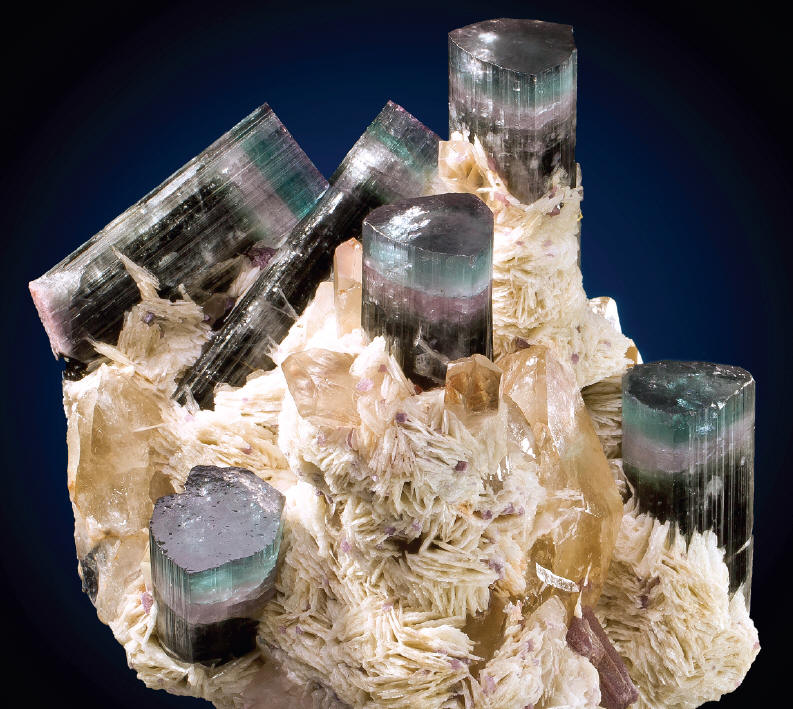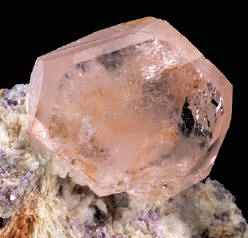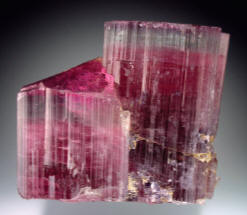One of the few big and aestheticspecimens was kept hidden for manyyears and introduced by Edward Swobodato the public for the first time onlyin 2012. This specimen is over 28 cm longand is built of big quartz crystals andtwo “blue-caps” sticking up from them;illustrated here on page 8. Rumor has itthat this piece was purchased by MarionStuart, an extremely wealthy collector atthat time, during a mine party, to be donatedto the LA museum. After purchasingit, she decided to keep the specimenin her collection rather than donating it.

Large specimen known as “six-pack” found in 1984 in six-pack pocket, 19.5 cm tall. Arkenstone specimen, now on display in the Perot Museum of Nature and Science in Dallas. J. Budd photo.

Beryl var. morganite crystal found in 1972, 5 cm wide. W. Larson collection. H. and E. Van Pelt photo.
She selected this specimen as the most aesthetic of the big ones, having only onerepair and bought it still dirty. What is interestingis that she had never cleaned itin her life! The specimen remained hiddenand only one polaroid photo of it wasknown. In the ‘90s the specimen was soldto James Horner still in a “big secret”and finally washed and trimmed. Todayit is owned by the Arkenstone company.
One of the few matrix specimensthat is not repaired is the 14 cm tall singlecrystal with a group of albite as a matrix.

Mine portal in mid 90’s with new cook shack on the right. E. Swoboda photo.
This specimen, pictured here on thecover, was also on the cover of the famous “Ikons” book. It shows an amazingcoloristic contrast and general aesthetics.
It is now owned by Pinnacle Collection.
“The Belly Button” is a smaller butalso very famous specimen and belongsto Peter Via. It is a single 13 cm high“blue-cap” tourmaline crystal with a biggemmy morganite crystal placed in themiddle of it looking like a button. It is illustratedhere on page 10. Its aestheticsand the paragenesis make this specimenreally unique.
A 12 cm high group of four “bluecap”crystals with quartz on the base isowned by Azurite Corporation and illustratedhere on page 7.
Another very distinctive specimencalled “The Beer Cans” resembling twobeer cans laying one on another, is 14 cmhigh and, as the name suggests, containsbeer can size tourmalines. It is illustratedhere on page 12.
After the “blue-cap” bonanza, PalaProperties International continued miningin the same area hoping to find moretourmalines. They drove many meters oftunnels but had not found any importantpockets.

Tourmaline found in 1973, 6.5 cm tall. C. Graeber collection. J. Fisher photo.
Finally in July 1974 the so called“Barlow Pocket” was hit. It was namedafter John Barlow who was in the mineat the time and helped to extract thespecimens. He bought most of them, includingthe huge “Barlow Buster” withtourmalines and morganites. Later, togetherwith Peter Bancroft, they restoredthe pocket as it looked in situ in themine.

Huge tourmaline with quartz, trimmed from specimen shown on page 3. 20 cm tall. S. Rudolph specimen. J. Scovil photo.
Finally in 1978 after mining hundredsof meters of tunnel, Pala PropertiesInternational decided to close themine. It is estimated that during theyears of its activity the company soldspecimens and gemstones worth over $1million.







 YueGongAnBei 44051102000467
YueGongAnBei 44051102000467


 |
|